Electricity class 10 Questions and Answers
In this post, you will find a set of selected questions and answers from the class 10 electricity chapter. This set consists of theoretical questions and numerical problems.
Electricity class 10 Questions and Answers (theoretical and numerical)
(1) Define electric current. What is the SI unit of electric current?
Answer] Electric current is the flow of electric charges (electrons) in a conductor such as a metal wire.
SI unit of electric current is ampere.
(2) One coulomb of charge flows through any cross-section of a conductor in 1 second. What is the current flowing through the conductor?
Answer] 1 ampere.
(3) Which instrument is used to measure electric current? How should it be connected in a circuit?
Answer] An ammeter is used to measure electric current. It should be connected in series with the circuit.
(4) What is the conventional direction of the flow of electric current? How does it differ from the direction of the flow of electrons?
ansewer] Conventional direction of flow of electric current is from the positive terminal of a battery to the negative terminal, through the outer circuit. The direction of the flow of electrons is opposite to the direction of conventional current, i.e. from negative terminal to positive terminal.
(5) A flash of lightning carries 10 C of charge which flows for 0.01 s. What is the current? If the voltage is 10 MV, what is the energy?
Solution :
Q=10 C.
t=0.01 s
I = Q/t = 10/0.01 A = 1000 A …….. (1)
PD = 10 x 106 V
energy = work done =W
W= PD x Q = 10 x 106 x 10 J = 108 J.
Question 6:
An electric heater is connected to the 230 V mains supply. A current of 8 A flows through the heater.
(a) How much charge flows around the circuit each second?
(b) How much energy is transferred to the heater each second?
Solution :
given: p.d = 230 v, I = 8A
a) t = 1 s
Q = I t = 8×1 C = 8 C
b)Energy transferred = work done = W
t=1 s
Q=as found in (a)
W=pd x Q = 230 x 8 J = 1840 J [Answer]
Question 7:
How many electrons are flowing per second past a point in a circuit in which there is a current of 5 amp?
Solution : time t= 1 s, current I = 5 A
Charge Q = I t = 5 x 1 C = 5 C
Say, the number of electrons = n
e = charge of an electron = 1.6 x 10-19 C
The total charge of n number of electrons = Q
so, ne =Q
=>n = Q/e = 5/[1.6 x 10-19] =31.25 x 1018
The number of electrons is 31.25 x 1018
Question 8:
A potential difference of 20 volts is applied across the ends of a resistance of 5 ohms. What current will flow in the resistance?
Solution :
Potential difference, V = 20V
Resistance, R = 5 ohms
Current, I =?
We know that
V=IR
20 = I x 5
I = 20/5 = 4 A
Question 9:
A resistance of 20 ohms has a current of 2 amperes flowing in it. What potential difference is there between its ends?
Solution:
R = 20 ohms
I = 2 A
We know that
V = IR
Thus,
V = 2 x 20
V = 40V
Question 10:
A current of 5 amperes flows through a wire whose ends are at a potential difference of 3 volts. Calculate the resistance of the wire.
Solution :
I = 5 A
p.d. V = 3 V
We know that
V=IR
Thus,
3 = 5 x R
R = 3/5 = 0.6 ohm
Question 11:
(a) What is meant by the “resistance of a conductor”? Write the relation between resistance, potential
difference and current.
(b) When a 12 V battery is connected across an unknown resistor, there is a current of 2.5 mA in the circuit. Calculate the value of the resistance of the resistor.
Solution :
(a) The property of a conductor due to which it opposes the flow of current through it is called resistance of the conductor.
Work done = Potential difference x charge moved.
(b) V = 12volt, I=2.5 x 10-3 A
We know that
V=IR
R=V/I
R=12/(2.5X10-3)
R=4.8X103ohm = 4800 ohm.
Question 12:
(a) Define the unit of resistance (or Define the unit “ohm”).
What happens to the resistance as the conductor is made thinner?
Keeping the potential difference constant, the resistance of a circuit is doubled. By how much does the current change?
Solution :
(a) 1 ohm is the resistance of a conductor such that when a potential difference of 1 volt is applied to its ends, a current of 1ampere flows through it.
(b) Its resistance will increase.
(c) V= IR
I = V/R
Keeping V constant, I is inversely proportional to R.
So if resistance is doubled, the current becomes half.
Question 13:
(a) Why do electricians wear rubber hand gloves while working with electricity?
(b) What p.d. is needed to send a current of 6 A through an electrical appliance having a resistance of 40 Ω?
Solution :
(a) Electricians wear rubber hand gloves while working with electricity because rubber is an insulator and protects them from electric shocks.
(b) I=6amp, R=40ohm
We know that
V=IR
V = 6 x 40 = 240 V.
Question 14
(i) Write down the formula which states the relationship between potential difference, current and resistance,
(ii) The potential difference between the terminals of an electric iron is 240 V and the current is 5.0 A. What is the resistance of the electric iron?
Solution :
(i) Potential difference = Current x Resistance
(ii) V = 240 volt, I = 5A
We know that
V=IR
240 = 5 x R
R = 240/5 = 48 ohm.
Question 15:
An electric room heater draws a current of 2.4 A from the 120 V supply line. What current will this room heater draw when connected to the 240 V supply line?
Solution :
In the first case,
I = 2.4 amp, V = 120 volt
V=IR
120 = 2.4 x R
R = 120/2.4 = 50 ohm
In the second case,
V = 240 volt, R = 50 ohm
V = IR
240 = I x 50
I =4.8 amp.
Question 16:
Name the electrical property of a material whose symbol is “omega”.
Solution :
Resistance.
Question 17:
The graph between V and I for a conductor is a straight line passing through the origin.
Which law is illustrated by such a graph?
What should remain constant in a statement of this law?
Solution :
(a) Ohm’s law
(b) Temperature.
Question 18:
A p.d. of 10 V is needed to make a current of 0.02 A flow through a wire. What p.d. is needed to make a current of 250 mA flow through the same wire?
Solution :
In the first case,
I = 0.02 amp, V = 10 volt
V=IR
10 = 0.02 x R
R = 10/0.02 = 500 ohm
In the second case,
I = 250 x 10-3 A, R = 500 ohm
V = IR
V = 250 x 10-3 x 500
V = 125 volt.
Question 19]
A current of 200 mA flows through a 4 kΩ resistor. What is the p.d. across the resistor?
Solution :
I = 200mA = 0.2 A
R = 4 x 103ohm = 4000 ohm
We know that
V=IR
V = 0.2 x 4000
V = 800 volt.
Question 20:
If the length of a wire is doubled by taking more of the wire, what happens to its resistance?
Solution: Resistance is directly proportional to the length of the wire. So when the length is doubled, resistance would also become double.
Question 21:
(a) What do you understand by the “resistivity” of a substance?
A wire is 1.0 m long, 0.2 mm in diameter and has a resistance of 10 Ω. Calculate the resistivity of its material.
Solution :
(a) Resistivity is the characteristic property of a substance which depends on the nature of the substance and its temperature. It is numerically equal to the resistance between the opposite faces of a 1 m cube of the substance.
(b) l = 1m
r = d/2 = 0.2/2 mm = 0.1 mm = 0.0001m,
R = 10 ohm
We know that,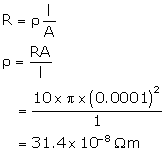
Question 22:
What will be the resistance of a metal wire of length 2 metres and area of cross-section 1.55 × 10-6 m2, if the resistivity of the metal is 2.8 × 10-8 Ωm?
Solution :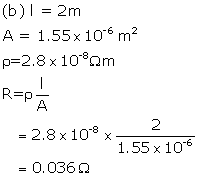
Question 23:
(a) Give two examples of substances which are good conductors of electricity. Why do you think they are
good conductors of electricity ?
Calculate the resistance of a copper wire 1.0 km long and 0.50 mm diameter if the resistivity of copper is 1.7 × 10-8 Ωm.
Solution :
(a) Silver and copper are good conductors of electricity because they have free electrons available for conduction.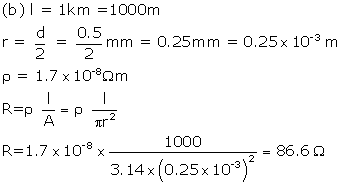
Question 24:
Calculate the resistance of an aluminium cable of length 10 km and diameter 2.0 mm if the resistivity of aluminium is 2.7 x 10-8Ωm.
Solution :
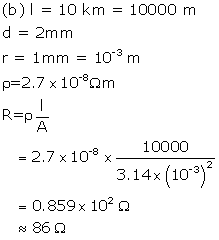
Question 25:
(a) Name a device which helps to maintain a potential difference across a conductor (say, a bulb).
If a potential difference of 10 V causes a current of 2 A to flow for 1 minute, how much energy is transferred?
Solution :
(a) Cell or battery helps to maintain a potential difference across a conductor.
(b) Given: p.d. = 10 V, I = 2 A, t = 1 min = 60s.
We know that:
I=Q/t.
Thus, Q=Ixt.
Q=2×60.
Q=120 C.
Work done = p.d. x charge moved
Work done = 120x10J
Work done = 1200J.
Question 26:
(a) Write down the formula which relates electric charge, time and electric current.
(b) A radio set draws a current of 0.36 A for 15 minutes. Calculate the amount of electric charge that flows through the circuit.
Solution :
(a). Q= Ix t
(b). I=0.36A, t=15min =900 seconds.
Q=Ixt
=0.36×900
=324 C.
Question 27:
If the charge on an electron is 1.6 x 10-19 coulombs, how many electrons should pass through a conductor in 1 second to constitute 1 ampere current?
Solution :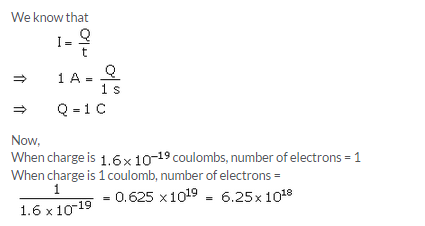
Question 28:
The p.d. across a lamp is 12 V. How many joules of electrical energy are changed into heat and light when :
(a) a charge of 1 C passes through it ?
(b) a charge of 5 C passes through it ?
(c) a current of 2 A flows through it for 10 s ?
Solution :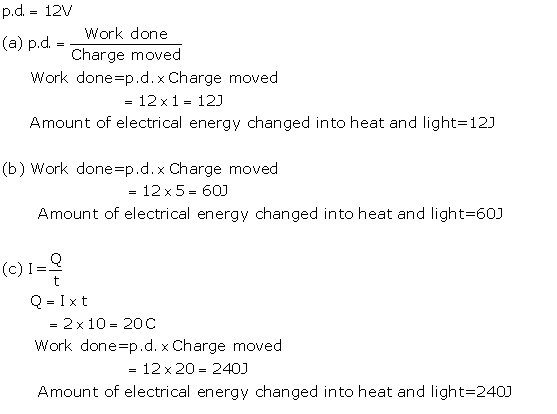
Lakhmir Singh Physics Class 10 Solutions Page No:12
Question 29:
In 10 s, a charge of 25 C leaves a battery, and 200 j of energy are delivered to an outside circuit as a result.
(a) What is the p.d. across the battery ?
(b) What current flows from the battery ?
Solution :
Question 30:
(a) Define electric current. What is the SI unit of electric current?
(b) One coulomb of charge flows through any cross-section of a conductor in 1 second. What is the current flowing through the conductor?
(c) Which instrument is used to measure electric current? How should it be connected in a circuit?
(d) What is the conventional direction of the flow of electric current? How does it differ from the direction of the flow of electrons?
(e) A flash of lightning carries 10 C of charge which flows for 0.01 s. What is the current ? If the voltage is 10 MV, what is the energy?
Solution :
(a) Electric current is the flow of electric charges (electrons) in a conductor such as a metal wire.
SI unit of electric current is ampere.
(b) 1 ampere.
(c) An ammeter is used to measure electric current. It should be connected in series with the circuit.
(d) Conventional direction of flow of electric current is from positive terminal of a battery to the negative terminal, through the outer circuit. The direction of flow of electrons is opposite to the direction of conventional current, i.e. from negative terminal to positive terminal.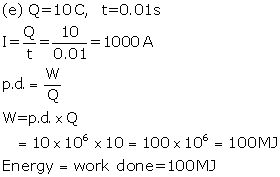
Question 31:
An electric heater is connected to the 230 V mains supply. A current of 8 A flows through the heater.
(a) How much charge flows around the circuit each second?
(b) How much energy is transferred to the heater each second?
Solution :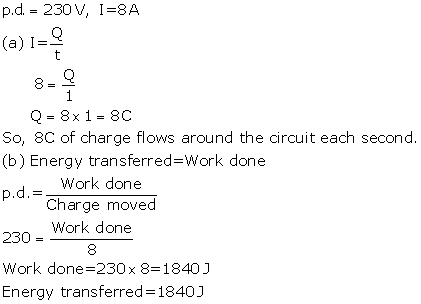
Question 32:
A potential difference of 20 volts is applied across the ends of a resistance of 5 ohms. What current will flow in the resistance?
Solution :
Potential difference, V = 20V
Resistance, R = 5ohms
Current, I =?
We know that
V=IR
20 = I x 5
I = 20/5 = 4 A
Question 33:
A resistance of 20 ohms has a current of 2 amperes flowing in it. What potential difference is there between its ends?
Solution :
R = 20ohms
I = 2amp
We know that
V = IR
Thus,
V = 2 x 20
V = 40V
Question 34:
A current of 5 amperes flows through a wire whose ends are at a potential difference of 3 volts. Calculate the resistance of the wire.
Solution :
I = 5amp
p.d., V = 3V
We know that
V=IR
Thus,
3 = 5 x R
R = 3/5 = 0.6 ohm
Question 35:
An electric room heater draws a current of 2.4 A from the 120 V supply line. What current will this room heater draw when connected to 240 V supply line ?
Solution :
In the first case,
I = 2.4 amp, V = 120 volt
V=IR
120 = 2.4 x R
R = 120/2.4 = 50 ohm
In the second case,
V = 240 volt, R = 50 ohm
V = IR
240 = I x 50
I =4.8 amp.
Question 36:
What happens to the resistance as the conductor is made thicker?
Solution :
The resistance decreases.
Question 37:
If the length of a wire is doubled by taking more of the wire, what happens to its resistance?
Solution :
Resistance also gets doubled.
Question 38:
On what factors does the resistance of a conductor depend?
Solution :
The resistance of a conductor depends on the following factors:-
Length of the conductor, area of cross-section of the conductor, nature of the material of the conductor and temperature of the conductor.
Question 39:
How does the resistance of a wire change when :
(i) its length is tripled?
(ii) its diameter is tripled?
(in) its material is changed to one whose resistivity is three times?
Solution :

Question 40:
Calculate the area of the cross-section of a wire if its length is 1.0 m, its resistance is 23 Ω and the resistivity of the material of the wire is 1.84 x 10-6 Ωm.
Solution :
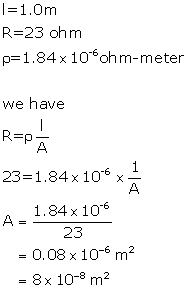
Question 41)
A piece of wire of resistance 20 Ω is drawn out so that its length is increased to twice its original length. Calculate the resistance of the wire in the new situation.


